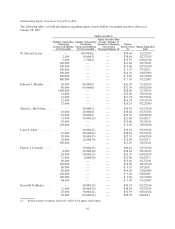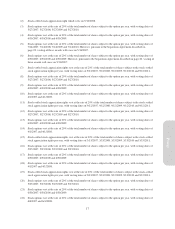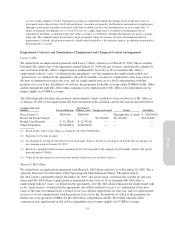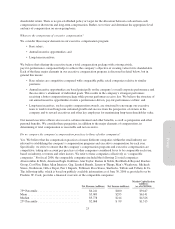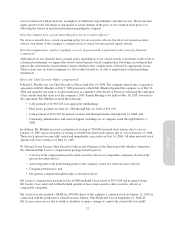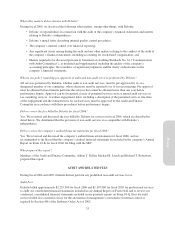Pottery Barn 2006 Annual Report Download - page 119
Download and view the complete annual report
Please find page 119 of the 2006 Pottery Barn annual report below. You can navigate through the pages in the report by either clicking on the pages listed below, or by using the keyword search tool below to find specific information within the annual report.
What are the criteria considered in awarding annual incentives?
Under the 2001 Incentive Bonus Plan, key performance criteria for evaluating executive officers include business
and financial objectives, and people and organizational goals, as well as other relevant factors as determined by
us with input from the company’s senior management. These criteria change from year to year. For fiscal 2006,
we determined that no portion of the total target bonus amount under the 2001 Incentive Bonus Plan would be
payable unless a prescribed company goal relating to company profitability (the “Company Objective”) was
achieved. No amount is payable under the 2001 Incentive Bonus Plan unless we previously certify that the
Company Objective has been achieved.
This target level, because it is based upon profitability, is deemed substantially uncertain for purposes of Internal
Revenue Code Section 162(m). When the goal was established, however, it was reasonably attainable based upon
the company’s historic and expected levels of profitability. Once the target level of profitability is reached, the
maximum amount payable is then available for payment to executive officers as fully deductible compensation.
However, we are permitted to apply negative discretion in determining the actual amount to be paid to any
executive officer. In determining how (or if) to apply such negative discretion, we measure company
performance against the business plan approved by the Board in the first fiscal quarter as well as individual
performance.
In the first quarter of each fiscal year, we review a performance report that summarizes whether, and to what
extent, the key performance criteria were attained for the prior fiscal year. The performance report also discusses
any other significant but unforeseen factors that may have positively or negatively affected the company’s
performance.
We verify the company’s actual earnings for each performance period, review management’s recommendation
for the resulting aggregate bonus awards and approve an aggregate award amount. We also review and approve
the individual bonuses payable to each of the company’s executive officers. The company’s Chief Executive
Officer approves the bonuses for all other eligible employees below the executive officer level. We decide the
bonus amount for the Chief Executive Officer in an executive session.
Based on the company’s performance in fiscal 2006 and certain brand-specific metrics, no annual incentive
bonuses were paid to the named executive officers for fiscal 2006.
How is long-term incentive compensation determined?
The third primary component of the company’s executive compensation program consists of equity
compensation awards. We continue to believe that equity compensation awards are important for motivating
executive officers and other employees to increase shareholder value over the long term. Prior to fiscal 2006, we
granted stock options to our executive officers. During fiscal 2006, we decided to begin granting SSARs since
they are accounted for identically to options but result in less dilution, both within the 2001 Long-Term Incentive
Plan and with respect to the company’s outstanding shares. We granted SSARs to each of the named executive
officers in fiscal 2006 as shown in the “Grants of Plan-Based Awards during Fiscal 2006” table on page 15. Our
equity awards to executive officers are designed to be competitive with those offered by comparable companies
for an executive’s job level, to reflect the company’s assessment of the executive’s ongoing contributions to the
company, to create an incentive for executives to remain with the company, and/or to provide a long-term
incentive to help the company achieve its financial and strategic objectives. Annual equity compensation awards
to our executive officers fall generally within the third quartile of equity awards to similarly situated executive
officers at comparable companies.
In determining the type and number of equity awards granted to an individual executive, we considered such
factors as:
• The type and number of awards previously granted to an individual;
• An individual’s outstanding awards;
25
Proxy



